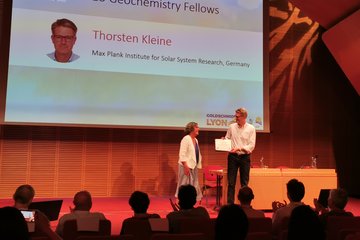Alle Typen
61.
Konferenzbeitrag
Microwave brightness temperature modelling of planetary atmospheres in preparation of GREAT and HIFI. In: Proceedings of ICSST04, S. 24 - 29. Allied publishers Pvt. Ltd, New Dehli, India (2006)
62.
Konferenzbeitrag
The microwave brightness of planetary atmospheres-preparatory modeling for GREAT and HIFI. In: Proceedings of the International Workshop on Critical Evaluation of mm-/submm-wave Spectroscopic Data for Atmospheric Observations, January 29-30, 2004, Ibaraki, Japan, S. 75 - 78 (Hg. Amano, T.; Kasai, Y.; Manabe, T.). Communications Research Laboratory (2004)
63.
Konferenzbeitrag
Water vapour measurements from the tropics to the pole during the THESEO campaign 1998/99. In: Final report to the European Commission, Environment and Climate Research Program, 1994-1998. JPL, California Institute of Technology, Pasadena, CA, USA (2001)
64.
Konferenzbeitrag
Comparison of MAS stratospheric ClO measurements with spaceborne, airborne, and ground-based experiments. In: Proceedings of the Quadrennial Ozone Symposium, S. 499 - 502. ANY PUBLISHER, L'Aquila, Italy (1998)
65.
Konferenzbeitrag
H2O in the Earth's atmosphere. In: Kleinheubacher Berichte, S. 186 - 193. (1998)
66.
Konferenzbeitrag
Analysis of forward models using the singular value decomposition algorithm. In: Satellite Remote Sensing of Clouds and the Atmosphere II, S. 163 - 173 (Hg. Haigh, J. D.). ANY PUBLISHER, London (1998)
67.
Konferenzbeitrag
Comparison of ozone profiles derived from ground-based microwave and lidar measurements. In: Microwave Remote Sensing of the Atmosphere and Environment, S. 202 - 209 (Hg. Wu, D. L.; Jin, Y.-Q.; Jiang, J.-S.). ANY PUBLISHER, Washington (1998)
68.
Konferenzbeitrag
Limb sounding of water vapor and liquid water down to the troposphere. In: Proc. 6th Int. Symp. on Recent Advances in Microwave Technology, Beijing, S. 580 - 583 (Hg. Rawal, B. S.; Siyong, Z.). Publishing House of Electronics Industry, Beijing (1997)
69.
Konferenzbeitrag
Groundbased detection of middle atmospheric water vapor. In: Global Process Monitoring and Remote Sensing of Ocean and Sea Ice, EUROPTO-Series 2586, S. 188 - 195. SPIE, Bellingham (1995)
70.
Konferenzbeitrag
Groundbased microwave detection of middle atmospheric ozone. In: Global Process Monitoring and Remote Sensing of Ocean and Sea Ice, EUROPTO-Series 2586, S. 206 - 214. SPIE, Bellingham (1995)
71.
Konferenzbeitrag
Retrieval of data from ground-based microwave sensing of the middle atmosphere: Comparison of two inversion techniques. In: Global Process Monitoring and Remote Sensing of Ocean and Sea Ice, EUROPTO-Series 2586, S. 196 - 205. SPIE, Bellingham (1995)
72.
Konferenzbeitrag
Millimeter wave detection of mesospheric ozone using a high resolution chirp transform spectrometer backend. In: Proc. IGARSS'94 on Surface and Atmospheric Remote Sensing: Technologies, Data Analysis and Interpretation, Pasadena, Vol. III, S. 3 - 5 (Hg. Stein, T. I.). Publ. Services IEEE, Piscataway, N. J. (1994)
73.
Konferenzbeitrag
Retrieval of mesospheric ozone from groundbased millimeter wave observations. In: Proc. IGARSS'94 on Surface and Atmospheric Remote Sensing: Technologies, Data Analysis and Interpretation, Pasadena, Vol. III, S. 1700 - 1702 (Hg. Stein, T. I.). Publ. Services IEEE, Piscataway, N. J. (1994)
74.
Vortrag
Ground-based measurements of HCN abundances in the stratosphere of Titan: an inter-comparison with Herschel observations. Asia Oceania Geosciences Society 18th Annual Meeting (AOGS2021), Online (2021)
75.
Vortrag
Observing atmospheric HCN on Titan from space and ground-based observatories: an inter-comparison study from Herschel, APEX and IRAM 30m telescopes. Europlanet Science Congress 2020, online (2020)
76.
Vortrag
HCN Submillimetre Remote Sensing of Titan's Atmosphere with the APEX and IRAM 30m Telescopes. 16th Annual Meeting, Asia Oceania Geosciences Society (AOGS), Singapore (2019)
77.
Vortrag
Spectral Scan and Line Catalogue of the Martian Atmosphere from Herschel-HIFI observations. European Planetary Science Congress 2018 , Berlin, Germany (2018)
78.
Vortrag
Spectral Scan and Line Catalogue of the Martian Atmosphere from Herschel-HIFI observations. Asia Oceania Geosciences Society (AOGS) 15th Annual Meeting , Honolulu, Hawaii (2018)
79.
Vortrag
Tracing the Oxygen-related Gas Composition of Titan's Atmosphere with Herschel. Water in the Universe: from Clouds to Oceans, Noordwijk, Netherlands (2016)
80.
Vortrag
What is Saturn's H2O External Source? 12th Annual Meeting Asia Oceania Geosciences Society, Singapore (2015)











